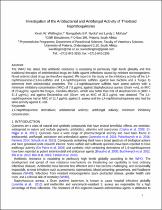 ResearchSpace
ResearchSpace
Investigation of the antibacterial and antifungal activity of thiolated naphthoquinones
JavaScript is disabled for your browser. Some features of this site may not work without it.
- ResearchSpace
- →
- Research Publications/Outputs
- →
- Journal Articles
- →
- View Item
| dc.contributor.author |
Wellington, Kevin W

|
|
| dc.contributor.author |
Nyoka, NBP

|
|
| dc.contributor.author |
McGaw, LJ

|
|
| dc.date.accessioned | 2019-02-04T06:44:02Z | |
| dc.date.available | 2019-02-04T06:44:02Z | |
| dc.date.issued | 2019-01 | |
| dc.identifier.citation | Wellington, K., Nyoka, N.B.P. and McGaw, L.J. 2019. Investigation of the antibacterial and antifungal activity of thiolated naphthoquinones. Drug Development Research: https://doi.org/10.1002/ddr.21512 | en_US |
| dc.identifier.issn | 1098-2299 | |
| dc.identifier.issn | 0272-4391 | |
| dc.identifier.uri | https://onlinelibrary.wiley.com/doi/full/10.1002/ddr.21512 | |
| dc.identifier.uri | https://doi.org/10.1002/ddr.21512 | |
| dc.identifier.uri | http://hdl.handle.net/10204/10676 | |
| dc.description | Copyright: 2019 Wiley. Due to copyright restrictions, the attached PDF file only contains the preprint version of the published item. For access to the published item, kindly consult the publisher's website. The definitive version of the work is published at https://doi.org/10.1002/ddr.21512 | en_US |
| dc.description.abstract | The WHO has stated that antibiotic resistance is escalating to perilously high levels globally and that traditional therapies of antimicrobial drugs are futile against infections caused by resistant microorganisms. Novel antimicrobial drugs are therefore required. We report in this study on the inhibitory activity of the 1,4-naphthoquinone-2,3-bis-sulfides and 1,4-naphthoquinone sulfides against two bacteria and a fungus to determine their antimicrobial properties. The 1,4-naphthoquinone sulfides have potent activity with a minimum inhibitory concentration (MIC) of 7.8 µg/mL against Staphylococcus aureus (Gram +ve), an MIC of 23.4µg/mL against the fungus, Candida albicans, which was better than that of Amphotericin B (MIC = 31.3 µg/mL), and against Escherichia coli (Gram -ve) an MIC of 31.3 µg/mL was obtained. The 1,4-naphthoquinone had an MIC of 11.7 µg/mL against S. aureus and the 1,4-naphthohydroquinone also had the same activity against E. coli. | en_US |
| dc.language.iso | en | en_US |
| dc.publisher | Wiley | en_US |
| dc.relation.ispartofseries | Worklist;21665 | |
| dc.subject | 1,4-Naphthoquinone derivatives | en_US |
| dc.subject | Antibacterial activity | en_US |
| dc.subject | Antifungal activity | en_US |
| dc.subject | Minimum inhibitory concentration | en_US |
| dc.title | Investigation of the antibacterial and antifungal activity of thiolated naphthoquinones | en_US |
| dc.type | Article | en_US |
| dc.identifier.apacitation | Wellington, K. W., Nyoka, N., & McGaw, L. (2019). Investigation of the antibacterial and antifungal activity of thiolated naphthoquinones. http://hdl.handle.net/10204/10676 | en_ZA |
| dc.identifier.chicagocitation | Wellington, Kevin W, NBP Nyoka, and LJ McGaw "Investigation of the antibacterial and antifungal activity of thiolated naphthoquinones." (2019) http://hdl.handle.net/10204/10676 | en_ZA |
| dc.identifier.vancouvercitation | Wellington KW, Nyoka N, McGaw L. Investigation of the antibacterial and antifungal activity of thiolated naphthoquinones. 2019; http://hdl.handle.net/10204/10676. | en_ZA |
| dc.identifier.ris | TY - Article AU - Wellington, Kevin W AU - Nyoka, NBP AU - McGaw, LJ AB - The WHO has stated that antibiotic resistance is escalating to perilously high levels globally and that traditional therapies of antimicrobial drugs are futile against infections caused by resistant microorganisms. Novel antimicrobial drugs are therefore required. We report in this study on the inhibitory activity of the 1,4-naphthoquinone-2,3-bis-sulfides and 1,4-naphthoquinone sulfides against two bacteria and a fungus to determine their antimicrobial properties. The 1,4-naphthoquinone sulfides have potent activity with a minimum inhibitory concentration (MIC) of 7.8 µg/mL against Staphylococcus aureus (Gram +ve), an MIC of 23.4µg/mL against the fungus, Candida albicans, which was better than that of Amphotericin B (MIC = 31.3 µg/mL), and against Escherichia coli (Gram -ve) an MIC of 31.3 µg/mL was obtained. The 1,4-naphthoquinone had an MIC of 11.7 µg/mL against S. aureus and the 1,4-naphthohydroquinone also had the same activity against E. coli. DA - 2019-01 DB - ResearchSpace DP - CSIR KW - 1,4-Naphthoquinone derivatives KW - Antibacterial activity KW - Antifungal activity KW - Minimum inhibitory concentration LK - https://researchspace.csir.co.za PY - 2019 SM - 1098-2299 SM - 0272-4391 T1 - Investigation of the antibacterial and antifungal activity of thiolated naphthoquinones TI - Investigation of the antibacterial and antifungal activity of thiolated naphthoquinones UR - http://hdl.handle.net/10204/10676 ER - | en_ZA |





